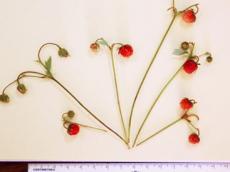|
|
TODAY.AZ / Weird / Interesting
Found new species of wild strawberry
13 July 2013 [09:37] - TODAY.AZ
 Can I get this job? Researchers have discovered a new species of wild mountain strawberry. It grows in the Cascade Mountains of Oregon, at elevations of 3,000 feet to about 5,000 feet.
Can I get this job? Researchers have discovered a new species of wild mountain strawberry. It grows in the Cascade Mountains of Oregon, at elevations of 3,000 feet to about 5,000 feet.The U.S. Department of Agriculture has already squirreled away a sample of the strawberry in its plant bank in Corvallis, Oregon. The U.S. agency manages the bank as a repository of genetic diversity for edible plants.
At first blush, the new strawberry looks much like other wild strawberries that grow throughout Washington, Oregon and California, says Kim Hummer, the USDA biologist who discovered the berry. Genetically, however, it's quite different. It has 10 sets of chromosomes, unlike other wild strawberries in the area, which have only eight. In fact, the only other 10-chromosome wild strawberry that scientists have identified grows on one Russian island northwest of Hokkaido, Japan. Grocery store strawberries have eight sets of chromosomes.
Having more chromosomes often make fruits bigger, but the new berry, which Hummer named Fragaria cascadensis, is small.
Other subtle differences set the "Cascade strawberry" apart. It has tiny hairs on the upper surface of its leaves and has comma-shaped, instead of teardrop-shaped, seeds on its surface. (Scientists actually consider each of those "seeds" a separate fruit. They're called achenes.)
Want to see and taste the new fruit for yourself? Hikers may find the berry growing on the western, wetter side of the Cascade Mountains, off the Pacific Crest Trail, Hummer tells Popular Science. It grows only in Oregon. Hummer suggests rubbing the leaves to feel if there are those telltale hairs. Some may be able to spot the hairs and the seed shape, although Hummer suggests a pocket magnifying glass for those with "older eyes."
The berries, which ripen in August, are edible. Hummer doesn't make them sound particularly tasty, however. "Flavor-wise, it had a sugar-acid mix. It has a white interior. It's soft," she says. "It would take a lot of developing to make a commercially viable fruit out of it."
/Popsci.Com/
URL: http://www.today.az/news/interesting/124543.html
 Print version
Print version
Views: 1453
Connect with us. Get latest news and updates.
See Also
- 06 December 2024 [22:20]
Are scented candles harmful to health? - 23 November 2024 [14:11]
Magnitude 4.5 earthquake hits Azerbaijan's Lachin - 20 November 2024 [23:30]
Launch vehicle with prototype of Starship made its sixth test flight - 27 October 2024 [09:00]
Fuel prices expected to rise in Sweden - 24 October 2024 [19:14]
Turkiye strikes terror targets in Iraq and Syria - 23 October 2024 [23:46]
Kazakhstan supplied almost entire volume of oil planned for 2024 to Germany in 9 months - 23 October 2024 [22:17]
Taiwan reported passage of Chinese Navy aircraft carrier near island - 23 October 2024 [21:50]
Russia remains largest oil supplier to India - 16 October 2024 [17:54]
Gamesummit co-founder shares insights on future of gaming industry in Azerbaijan [EXCLUSIVE] - 12 October 2024 [18:27]
TikTok cuts jobs, turns to AI for content moderation
Most Popular
 Azerbaijan, Colombia Discuss Cooperation in Various Fields
Azerbaijan, Colombia Discuss Cooperation in Various Fields
 Azerbaijan and Qatar strengthen environmental cooperation, says Minister
Azerbaijan and Qatar strengthen environmental cooperation, says Minister
 Armenian History in Crisis: Mirzoyan, Textbook and Colosseum
Armenian History in Crisis: Mirzoyan, Textbook and Colosseum
 Azerbaijani delegation attends "Vietnam Defence Expo 2024" in Hanoi
Azerbaijani delegation attends "Vietnam Defence Expo 2024" in Hanoi
 West has no interest in him: the United States has disowned Vardanyan
West has no interest in him: the United States has disowned Vardanyan
 Azerbaijan participates in 11th D8 Economic Cooperation Organization summit
Azerbaijan participates in 11th D8 Economic Cooperation Organization summit
 Azerbaijani and Turkish parliament speakers meet in Ankara
Azerbaijani and Turkish parliament speakers meet in Ankara
